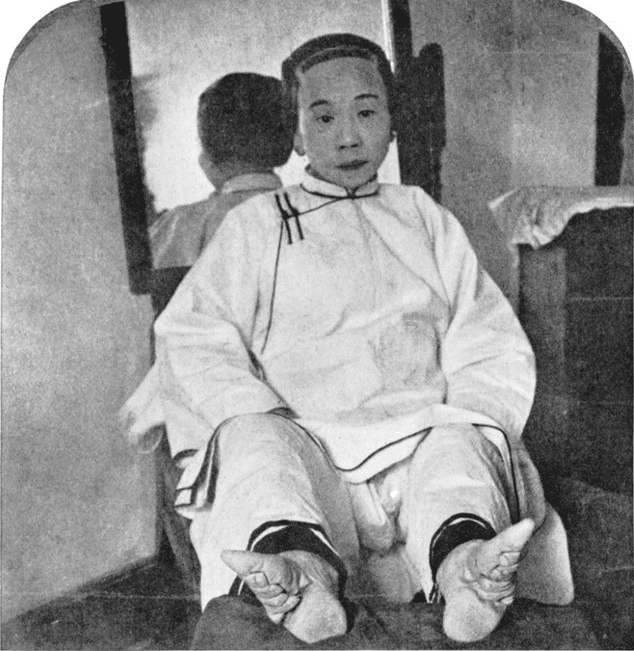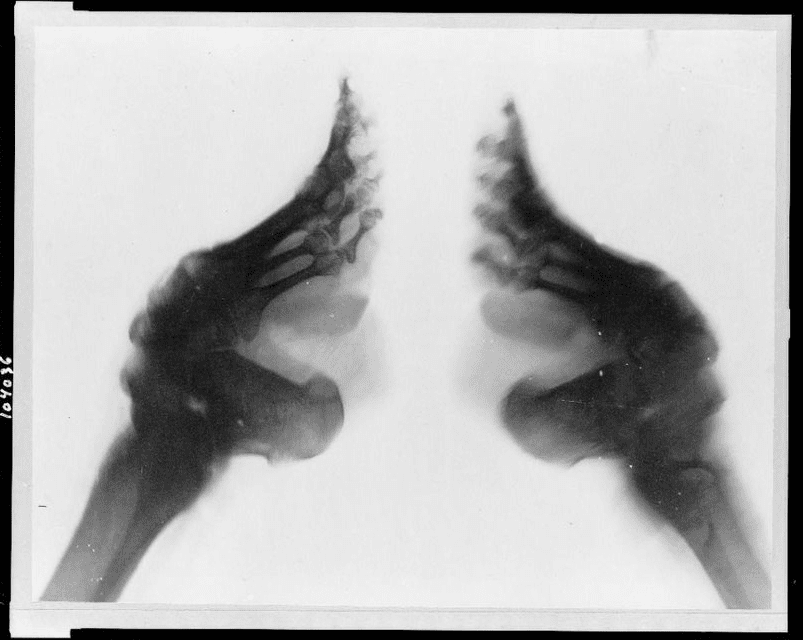Howard Fischer
Uppsala, Sweden
“Foot binding is the most incendiary and least controversial subject in modern Chinese history.”1
– Dorothy Ko, professor of History and Women’s Studies, Barnard College

Foot binding was practiced in China from the tenth century through most of the twentieth century. It involved breaking the bones and tightly binding the feet of young girls in order to produce a change in their size and shape. In the nineteenth century, 40 to 50% of all Chinese women and nearly all upper-class women had their feet bound. The goal of foot binding was to produce a cone-shaped foot no more than four inches long2,3 (a “golden lotus”). Some Chinese women, supported by Christian missionaries, started to voice opposition to the practice around 1880. The Republic of China was established in 1912 and foot binding was officially forbidden. However, the law was largely ignored. When China became a communist state in 1949, this ban was strictly enforced. The last new case of foot binding occurred in 1957 in Yunnan.4,5
This painful, sometimes handicapping ritual was performed on girls so that as adults, they would be “beautiful,” able to get a good husband, and show their high status. The bound foot was considered an erotic object, and the gait of women with bound feet was considered alluring. “Tiny foot” beauty contests were held.6 Recent thinking suggests that foot binding was a way to keep daughters at home, where they were needed to help the family financially by producing embroidery for sale.7 Foot binding was more common in the north, since in southern China women needed to work in the submerged rice fields, an occupation not compatible with bound feet.8 In the gai (beggar) social class, women were not permitted to have bound feet, nor could men get an education.9

The painful procedure started when a girl was between four and nine years old, most often at age five. Usually it began in winter when the feet were likely to be numb. The toenails were cut short and the feet soaked in a mixture of herbs and animal blood. The toes were bent and pressed tightly into the sole of the foot until the toes broke. The broken toes were held tightly against the sole. The foot was then pulled down to be in a straight line with the leg, and the arch of the foot was broken. Bandages were placed to keep the ball of the foot close to the heel. The bandage ends were sewn so that they could not be loosened.
One to three times a week, the bandages were removed, the foot washed, and the bandages placed again, tighter than before. Sometimes, despite being cut short, toenails would become ingrown. Skin infection might result, leading to bone infection, necrosis of the toe, and possibly septicemia. About 10% of girls died this way.10 After two or three years of foot binding with repeated manipulations and fractures, “the desired effect” was achieved.11 The feet often remained painful for the woman’s lifetime, and also hindered her mobility.
An English physician working in China in 1893 saw a patient’s foot fall off as a result of gangrene produced by constricting bandages. The other foot was so necrotic that it required amputation.12 A century later, researchers studied fifty-five women, aged 70–80 years, who had bound feet. The eighty-year-olds with bound feet reported twice as many falls as a non-bound control group. They also had more difficulty bending and squatting.13
Chinese foot binding has been compared to the Western habit of using a corset to reduce the size of a woman’s waist.14 Usually a corseted waist was 23–31 inches in circumference. A fad in the late nineteenth and early twentieth centuries was the “wasp waist,” a waist 16–18 inches in circumference. (Coincidentally, if a Barbie doll were an adult woman 5 feet 9 inches tall, her waist would be 18 inches.15) This was also a means of becoming “beautiful,” and of attracting a husband. At the very least, this excessive compression produced respiratory problems.16 It was, however, not done to young girls, and did not produce fractures. It was “voluntary,” if one discounts the social pressure to conform to this standard of beauty.
References
- Dorothy Ko. “Perspectives on foot binding,” ASIANetwork Exchange, XV (3), 2008.
- “Foot binding.” Wikipedia.
- Lily Chan. “Foot binding in Chinese women and its psychosocial implications,” Canadian Journal of Psychiatry, 15, 1970. https://doi.org/10.1177/070674377001500218.
- Ko, “Perspectives.”
- “Foot binding.” Wikipedia.
- Chan, “Psychosocial.”
- Ko, “Perspectives.”
- “Foot binding. Wikipedia.
- “Foot binding in China.” UBC Wiki, April 7, 2020. https://wiki.ubc.ca/Foot_Binding_in_China.
- “Foot binding.” Wikipedia.
- Chan, “Psychosocial.”
- Marie Haslep. “Notes on foot binding,” The China Medical Missionary Journal, 1893.MedNexus. https://mednexus.org/doi/abs/10.3760/cma.j.issn.0366-6999.1893.02.107.
- Steven Cummings et al. “Consequences of foot binding among older women in Beijing, China,” Am J Public Health, 87(10), 1997. doi: 10.2105/AJPH.87.10.1677.
- Amanda Foreman. “Why foot binding persisted in China for a millenium,” Smithsonian, 2015. https://smithsonianmag.com/history/why-footbinding-persisted-china-millennium-180953971/.
- “Barbie.” Wikipedia.
- “Wasp waist.” Wikipedia.
HOWARD FISCHER, M.D., was a professor of pediatrics at Wayne State University School of Medicine, Detroit, Michigan.
Highlighted Vignette Volume 15, Issue 2 – Spring 2023

Leave a Reply